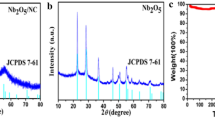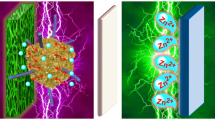Abstract
Metal oxides are promising candidates as the anodes of next-generation lithium ion batteries. However, the low electronic conductivities hinder their practical applications. Herein, through a facile calcination process using ammonium bicarbonate (NH4HCO3) as the N source, the nitrogen heteroelement was introduced into the ZnO/CoO micro-/nanospheres, which greatly improves the conductivity of the composites. As the lithium-ion battery anode, the N-doped ZnO/CoO micro-/nanosphere demonstrates much enhanced electrochemical performance. It displays a high initial capacity of 911.8 mA h/g at a current density of 0.2 A/g and long-term cycling stability, with a reversible capacity of 977.8 mA h/g remained after 500 cycles at a current density of 1 A/g. Furthermore, the N-doped ZnO/CoO composite presents an outstanding rate performance, with 605 mA h/g remained even at 5 A/g. The excellent electrochemical properties make N-doped ZnO/CoO micro-/nanospheres a promising candidate as high-performance anodes for next-generation rechargeable LIBs.






Similar content being viewed by others
References
A. Manthiram: Materials challenges and opportunities of lithium ion batteries. J. Phys. Chem. Lett. 2, 373 (2011).
L. Lu, X. Han, J. Li, J. Hua, and M. Ouyang: A review on the key issues for lithium-ion battery management in electric vehicles. J. Power Sources 226, 272 (2013).
B. Scrosati, J. Hassoun, and Y-K. Sun: Lithium-ion batteries. A look into the future. Energy Environ. Sci. 4, 3287 (2011).
L. Shen, S. Chen, J. Maier, and Y. Yu: Carbon-coated Li3VO4 spheres as constituents of an advanced anode material for high-rate long-life lithium-ion batteries. Adv. Mater. 29, 1701571–1701577 (2017).
X. Xu, R. Zhao, W. Ai, B. Chen, H. Du, L. Wu, H. Zhang, W. Huang, and T. Yu: Controllable design of MoS2 nanosheets anchored on nitrogen-doped graphene: Toward fast sodium storage by tunable pseudocapacitance. Adv. Mater. 30, 1800658–1800664 (2018).
M.R. Lukatskaya, B. Dunn, and Y. Gogotsi: Multidimensional materials and device architectures for future hybrid energy storage. Nat. Commun. 7, 12647–12659 (2016).
P. Poizot, S. Laruelle, S. Grugeon, L. Dupont, and J.M. Tarascon: Nano-sized transition-metal oxides as negative-electrode materials for lithium-ion batteries. Nature 407, 496 (2000).
L. Ji, Z. Lin, M. Alcoutlabi, and X. Zhang: Recent developments in nanostructured anode materials for rechargeable lithium-ion batteries. Energy Environ. Sci. 4, 2682 (2011).
D. Jiaojiao, Y. Xiaoliang, H. Yanbing, L. Baohua, Y. Quan-Hong, and K. Feiyu: A sliced orange-shaped ZnCo2O4 material as anode for high-performance lithium ion battery. Energy Storage Mater. 6, 61 (2017).
Y. Sharma, N. Sharma, G.V.S. Rao, and B.V.R. Chowdari: Nanophase ZnCo2O4 as a high performance anode material for Li-ion batteries. Adv. Funct. Mater. 17, 2855 (2007).
N. Du, Y. Xu, H. Zhang, J. Yu, C. Zhai, and D. Yang: Porous ZnCo2O4 nanowires synthesis via sacrificial templates: High-performance anode materials of Li-ion batteries. Inorg. Chem. 50, 3320 (2011).
H. Liu and J. Wang: One-pot synthesis of ZnCo2O4 nanorod anodes for high power lithium ions batteries. Electrochim. Acta 92, 371 (2013).
W. Luo, X. Hu, Y. Sun, and Y. Huang: Electrospun porous ZnCo2O4 nanotubes as a high-performance anode material for lithium-ion batteries. J. Mater. Chem. 22, 8916 (2012).
Z. Wang, L. Zhou, and X.W. Lou: Metal oxide hollow nanostructures for lithium-ion batteries. Adv. Mater. 24, 1903 (2012).
Y. Zhu, C. Cao, J. Zhang, and X. Xu: Two-dimensional ultrathin ZnCo2O4 nanosheets: General formation and lithium storage application. J. Mater. Chem. A 3, 9556 (2015).
Y. Zhao, X. Li, B. Yan, D. Xiong, D. Li, S. Lawes, and X. Sun: Recent developments and understanding of novel mixed transition-metal oxides as anodes in lithium ion batteries. Adv. Energy Mater. 6, 1502175 (2016).
J. Mei, T. Liao, L. Kou, and Z. Sun: Two-Dimensional metal oxide nanomaterials for next-generation rechargeable batteries. Adv. Mater. 29, 1700176 (2017).
J. Mei, T. Liao, H. Spratt, G.A. Ayoko, X. Zhao, and Z. Sun: Honeycomb-inspired heterogeneous bimetallic Co–Mo oxide nanoarchitectures for high-rate electrochemical lithium storage. Small Methods 3, 1900055 (2019).
A.K. Rai, T. Trang Vu, B.J. Paul, and J. Kim: Synthesis of nano-sized ZnCo2O4 anchored with graphene nanosheets as an anode material for secondary lithium ion batteries. Electrochim. Acta 146, 577 (2014).
B. Liu, X. Wang, B. Liu, Q. Wang, D. Tan, W. Song, X. Hou, D. Chen, and G. Shen: Advanced rechargeable lithium-ion batteries based on bendable ZnCo2O4-urchins-on-carbon-fibers electrodes. Nano Res. 6, 525 (2013).
Q. Ru, X. Song, Y. Mo, L. Guo, and S. Hu: Carbon nanotubes modified for ZnCo2O4 with a novel porous polyhedral structure as anodes for lithium ion batteries with improved performances. J. Alloys Compd. 654, 586 (2016).
Y. Chunshuang, Z. Yue, L. Yutao, F. Zhiwei, P. Lele, Z. Xin, C. Gang, and Y. Guihua: Local built-in electric field enabled in carbon-doped Co3O4 nanocrystals for superior lithium-ion storage. Adv. Funct. Mater. 28, 1705951 (2018).
T. Subburaj, K. Prasanna, K.J. Kim, P.R. Ilango, Y.N. Jo, and C.W. Lee: Structural and electrochemical evaluation of bismuth doped lithium titanium oxides for lithium ion batteries. J. Power Sources 280, 23 (2015).
J. Xu, Z. Liao, J. Zhang, B. Gao, P.K. Chu, and K. Huo: Heterogeneous phosphorus-doped WO3−x/nitrogen-doped carbon nanowires with high rate and long life for advanced lithium-ion capacitors. J. Mater. Chem. A 6, 6916 (2018).
Y. Wang, X. Xue, P. Liu, C. Wang, X. Yi, Y. Hu, L. Ma, G. Zhu, R. Chen, and T. Chen: Atomic substitution enabled synthesis of vacancy-rich two-dimensional black TiO2−x nanoflakes for high-performance rechargeable magnesium batteries. ACS Nano 12, 12492 (2018).
G. Wu, Z. Jia, Y. Cheng, H. Zhang, X. Zhou, and H. Wu: Easy synthesis of multi-shelled ZnO hollow spheres and their conversion into hedgehog-like ZnO hollow spheres with superior rate performance for lithium ion batteries. Appl. Surf. Sci. 464, 472 (2019).
M. Xu, S. He, H. Chen, G. Cui, L. Zheng, B. Wang, and M. Wei: TiO2−x-modified ni nanocatalyst with tunable metal–support interaction for water–gas shift reaction. ACS Catal. 7, 7600 (2017).
S. Liu, J. Zhou, and H. Song: 2D Zn-hexamine coordination frameworks and their derived N-rich porous carbon nanosheets for ultrafast sodium storage. Adv. Energy Mater. 8, 1800569 (2018).
X. Huang, X. Xia, Y. Yuan, and F. Zhou: Porous ZnO nanosheets grown on copper substrates as anodes for lithium ion batteries. Electrochim. Acta 56, 4960 (2011).
B. Das, M. Reddy, G.S. Rao, and B. Chowdari: Synthesis of porous-CoN nanoparticles and their application as a high capacity anode for lithium-ion batteries. J. Mater. Chem. 22, 17505 (2012).
B. Das, M. Reddy, P. Malar, T. Osipowicz, G.S. Rao, and B. Chowdari: Nanoflake CoN as a high capacity anode for Li-ion batteries. Solid State Ionics 180, 1061 (2009).
J. Deng, X. Yu, X. Qin, B. Li, and F. Kang: Carbon sphere-templated synthesis of porous yolk–shell ZnCo2O4 spheres for high-performance lithium storage. J. Alloys Compd. 780, 65 (2019).
J. Deng, X. Yu, X. Qin, D. Zhou, L. Zhang, H. Duan, F. Kang, B. Li, and G. Wang: Co–B nanoflakes as multifunctional bridges in ZnCo2O4 micro-/nanospheres for superior lithium storage with boosted kinetics and stability. Adv. Energy Mater. 9, 1803612 (2019).
J. Deng, X. Yu, X. Qin, B. Liu, Y-B. He, B. Li, and F. Kang: Controlled synthesis of anisotropic hollow ZnCo2O4 octahedrons for high-performance lithium storage. Energy Storage Mater. 11, 184 (2018).
J. Deng, X. Yu, Y. He, B. Li, Q-H. Yang, and F. Kang: A sliced orange-shaped ZnCo2O4 material as anode for high-performance lithium ion battery. Energy Storage Mater. 6, 61 (2017).
Y. Jiang, Y. Song, Z. Pan, Y. Meng, L. Jiang, Z. Wu, P. Yang, Q. Gu, D. Sun, and L. Hu: Rapid amorphization in metastable CoSeO3·H2O nanosheets for ultrafast lithiation kinetics. ACS Nano 12, 5011 (2018).
Y. Li, Y. Zhao, C. Ma, and Y. Zhao: Promising carbon matrix derived from willow catkins for the synthesis of SnO2/C composites with enhanced electrical performance for Li-ion batteries. Nano 13, 1850087 (2018).
Acknowledgments
The authors acknowledge the financial support of the National Natural Science Foundation of China (51502147), Natural Science Foundation of Inner Mongolia (2015BS0510), China Postdoctoral Science Foundation (2017M611205), Fund of Key Laboratory of Advanced Materials of Ministry of Education (No. 2016AML08), Inner Mongolia scientific and technological achievements transformation project (CGZH2018132), and Inner Mongolia Innovation project for postgraduates (Nos. B20171012804Z and S20171012807).
Author information
Authors and Affiliations
Corresponding authors
Rights and permissions
About this article
Cite this article
Deng, X., Li, S., Wang, J. et al. Nitrogen-doped zinc/cobalt mixed oxide micro-/nanospheres for high-rate lithium-ion battery anode. Journal of Materials Research 34, 3204–3211 (2019). https://doi.org/10.1557/jmr.2019.258
Received:
Accepted:
Published:
Issue Date:
DOI: https://doi.org/10.1557/jmr.2019.258




